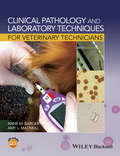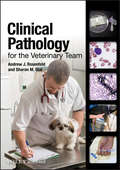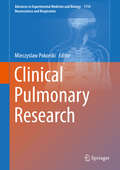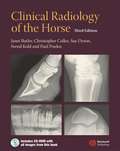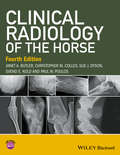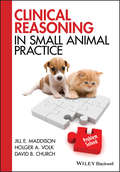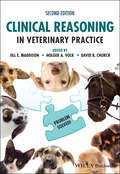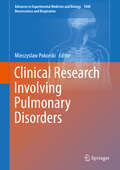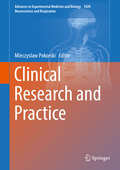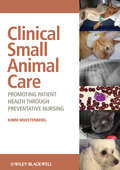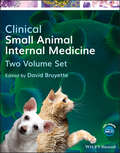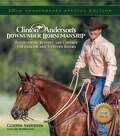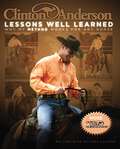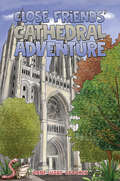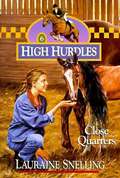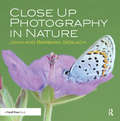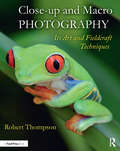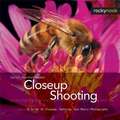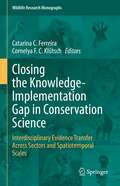- Table View
- List View
Clinical Pathology and Laboratory Techniques for Veterinary Technicians
by Anne M. Barger Amy L. MacneillClinical Pathology and Laboratory Techniques for Veterinary Technicians provides a comprehensive reference of laboratory procedures featuring 'how-to' information as it pertains to small animals, horses, and cattle. An inclusive reference of laboratory procedures pertaining to small animals, horses and cattle Provides information on hematology, hemostasis, clinical chemistry, urinalysis, parasitology, and fecal testing Features high-quality photographs labelled with magnification and stain information, which clearly depict cellular morphology, inclusions and infectious organisms Offers key objectives, technician tip boxes, case examples and a glossary of key terms A companion website provides images from the book for download, instructor questions and answer key to multiple choice questions in the book
Clinical Pathology for the Veterinary Team
by Andrew J. Rosenfeld Sharon M. DialClinical Pathology for the Veterinary Team is a concise, reliable resource for technical team members performing clinical diagnostic evaluation. Focusing on sample handling, machinery calibration, normal physiology and anatomy, clinical diagnostics, and disease processes, the book helps technical team members to consistently achieve high-quality results in small animal lab work. An essential bench-side reference for in-house laboratories, the book includes a DVD with interactive cases to build skills in reading and interpreting digital slides. With chapters on blood counts, chemistry, urinalysis and electrolytes, advanced diagnostics, and cytology, Clinical Pathology for the Veterinary Team offers key technical information for consistently obtaining and evaluating samples. The book is a practical resource for anyone performing lab work, including veterinary technicians, technician and veterinary students, and veterinarians.
Clinical Pulmonary Research (Advances in Experimental Medicine and Biology #1114)
by Mieczyslaw PokorskiThis book describes various aspects of current scientific interest in clinical developments and management of pulmonary pathologies. Non-communicable and communicable disorders are tackled. Chronic disorders of an inflammatory background, such as COPD and asthma, often overlapping, diagnostically and therapeutically misguided and always difficult to manage, are in focus due to an increasing prevalence across the age range. The authors dwell on the disease management, exacerbations, care and therapy, taking into account all too often overlooked psychosomatic determinants. Novel markers of pulmonary sarcoidosis, also an inflammatory disease, albeit of unknown etiology, are described. The outstanding lung images of cystic fibrosis are presented in another chapter. Finally, there are reports on the extent of the influenza scourge in Poland during the past 2016/2017 epidemic season. The book is addressed to clinicians, family physicians, medical scholars, and all professionals engaged in the preservation of respiratory health.
Clinical Radiology of the Horse
by Christopher Colles Janet A. Butler Paul W. Poulos Sue J. Dyson Svend E. KoldClinical Radiology of the Horse is the only book dedicated to the horse which provides a comprehensive overview of radiography and radiology of all areas of the horse. It provides a thorough guide both to the techniques used to obtain radiographs of the horse and to radiographic interpretation. With almost 600 superb annotated radiographs and more than 120 line diagrams, the book combines the best features of a high quality atlas and those of a detailed reference book. The normal radiographic anatomy of immature and mature horses is presented with normal variations, incidental findings and details of significant abnormalities. Remarks on clinical prognosis and treatment are also included. The emphasis throughout is on practical tips, common pitfalls, and the techniques used to obtain the best radiographs of specific areas and conditions. Changes for the third edition: Significantly enlarged to include a chapter on digital radiography Includes descriptions of several new radiographic projections Many of the images have been replaced by digital images A wealth of new illustrations have been added Presents expanded information on processing and image quality Updated to include new information, knowledge gained from continued clinical experience and the most relevant references from recent literature CD included with the book presents all the radiographic images in electronic format Since publication of the Second Edition, there have been major advances in other imaging techniques, including scintigraphy, ultrasonography, computed tomography and magnetic resonance imaging. This third edition still focuses on radiography and radiology, but acknowledges the limitations of radiography in some circumstances. In these situations, reference is made to other imaging techniques which may be appropriate, along with suggestions for further reading.
Clinical Radiology of the Horse
by Christopher M. Colles Janet A. Butler Paul W. Poulos Sue J. Dyson Svend E. KoldClinical Radiology of the Horse is the best-selling, practical guide to all areas of equine radiography and radiology written by an experienced group of clinicians with a broad range of backgrounds. Offers an atlas of normal and clinical images, as well as a comprehensive guide to techniques, equipment, positioning, and interpretation for general veterinary practitioners and specialists in imaging and orthopaedics Updates to this fourth edition fully reflect the move to digital imaging with many new figures in the book and major revisions to the chapters on the head, thorax, and abdomen Contains expanded coverage of the foot, pastern, and fetlock (now in separate chapters) Includes a password-protected website with all the images from the book as well as over 200 additional images with examples of more subtle lesions, more fractures, correct technique and positioning versus incorrect, immature horses, progression of disease, and pathological images Offers an atlas of normal and clinical images, as well as a comprehensive guide to techniques, equipment, positioning, and interpretation for general veterinary practitioners and specialists in imaging and orthopaedics
Clinical Reasoning in Small Animal Practice
by Holger A. Volk Jill E. Maddison David B. ChurchClinical Reasoning in Small Animal Practice presents a revolutionary approach to solving clinical problems. As a veterinarian, especially as a student or new graduate, a ten minute consultation in a busy small animal practice can be a daunting task. By guiding you to think pathophysiologically, this book will help solve clinical problems as efficiently as possible. The authors set out a structured approach with easy to remember rules which can be applied to most clinical signs small animals present with. This reduces the need to remember long lists of differentials and avoids the potential of getting trapped by a perceived obvious diagnosis. The book will help to unlock your potential to solve clinical problems. It also provides a logical rationale for choosing diagnostic tests or treatments which can be clearly communicated to the owner. Written by internationally renowned clinicians and educators in clinical reasoning, key features of the book include: An easy to remember and logical approach to solving a wide range of clinical problems encountered in small animal medicine and neurology An invaluable resource for every level of learner, from student to experienced practitioner Flowcharts and key step markers throughout help illustrate the decision making processClinical inductive reasoning offers you the ability to solve cases more efficiently, resulting in better treatment and care for pets and happier owners. Clinical Reasoning in Small Animal Practice will help turn a terrifying case into a manageable one!
Clinical Reasoning in Veterinary Practice: Problem Solved!
by Holger A. Volk Jill E. Maddison David B. ChurchThe new edition of this innovative textbook on clinical reasoning in veterinary medicine, provides a simple and logical approach for solving a wide range of clinical problems Clinical Reasoning in Veterinary Practice: Problem Solved! 2nd Edition continues to provide a revolutionary approach for rapidly and efficiently solving clinical problems encountered in veterinary medicine. Featuring new problem-based clinical reasoning examples, the second edition expands its problem-based approach to cover new problems of the eye, of exotic pets, and in equine practice. Another new chapter describes the principles of professional reasoning and decision making. The text content and format is fully revised based on universal design principles and will make clinical reasoning simpler to understand for readers with different learning styles. Provides a logical approach to common clinical problems in small animal practice such as vomiting, diarrhoea, weight loss, weakness, gait abnormalities, bleeding and more Includes examples of common problems in exotic and equine practice and how to assess them using a problem-solving approach Offers the logical rationale for selecting diagnostic tests Features contributions by internationally recognised clinicians and educators in clinical and professional reasoning Helps veterinary practitioners clearly communicate their decision-making to animal owners Contains flowcharts and key step markers that illustrate the decision-making processClinical Reasoning in Veterinary Practice: Problem Solved! 2nd Edition is the perfect textbook for undergraduate veterinary students and an invaluable resource for new graduates and experienced veterinary practitioners alike.
Clinical Research Involving Pulmonary Disorders (Advances in Experimental Medicine and Biology #1040)
by Mieczyslaw PokorskiThis book presents the current trends and state of the art solutions addressing various issues related to pulmonary disorders. Diagnostic and therapeutic challenges are tackled, starting with the noncommunicable diseases of sarcoidosis and granulomatosis with polyangiitis. Pulmonary involvement, practically unavoidable, runs an insidious course, and is often occulted by systemic symptoms. The establishment of a firm diagnosis, with a precision no one could oppugn, is difficult. Other issues pertain to quality of life, disease preventive measures, and the move toward personal health care in chronic sufferers from multiple conditions in later life. There is also an update on the prevalence and diagnostic and treatment challenges of extrapulmonary tuberculosis. In addition, the place of neuroproteomics in modern clinical practice is presented. The practical insights emphasize the role of science in advancing biomedical knowledge and care. The book is addressed to researchers and practitioners, and allied health care professionals engaged in effective patient care and therapy.
Clinical Research and Practice (Advances in Experimental Medicine and Biology #1020)
by Mieczyslaw PokorskiThis book is a blend of medical research and clinical practice. Advancements in practice are inextricably bound to have research underpinnings. The articles highlight a range of practical topics. The respiratory tract is upfront as the first line of defense of the organism. Virological and bacteriological aspects of the infections that continue to be a scourge worldwide, influenza and tuberculosis, are dealt with. Sleep disordered breathing is another hot topic. Allergy and atopy, and the role of nutraceuticals in providing anticancer benefits due to the inhibitory effects on tumor growth and angiogenesis are referred to. Other chapters describe the use of mesenchymal stem cells for regeneration of the worn away cartilage tissue in the knee. The assessment and management of cognitive decline, sarcopenia and frailty of old age also figure prominently in the texts. The book is an attempt to demonstrate the viability of a bench-to-bedside design in point-of-care patient applications. Hopefully, it will be a source of information on interdisciplinary medical research advancements, addressing the needs of medical professionals, from scientists to clinicians and allied health professionals.
Clinical Signs in Small Animal Medicine (Manson Ser.)
by Michael Schaer D.V.M.This new edition of the bestselling Clinical Signs in Small Animal Medicine presents 800 all new color photographs of the highest quality, with detailed captions that focus on key pointers to diagnosis and treatment. The book is organised into chapters by body system, each beginning with a list of ‘Clinical Pearls'. These amusing and accurate key points will be invaluable when considering conditions or highlighting common concerns. Within each chapter, the superb photographs of real cases are annotated with brief, key information that provides a succinct and useful reminder of lessons learned.
Clinical Small Animal Care: Promoting Patient Health through Preventative Nursing
by Kimm WuestenbergClinical Small Animal Care: Promoting Patient Health through Preventative Nursing is an introduction to the principles of day-to-day veterinary practice, with coverage ranging from the initial assessment, fluid therapy monitoring, and perioperative management to care of animals with specific diseases. The book offers concrete guidance on best practices for promoting patient health in veterinary care, emphasizing specific techniques to prevent complications before they happen. A practical, clinically relevant resource for veterinary technicians, Clinical Small Animal Care provides step-by-step descriptions of the core tasks associated with examining, nursing, and monitoring small animal patients. Taking a hands-on approach to the fundamentals of clinical practice, the book gives specific advice for how to perform tasks associated with patient care. Chapters begin with basic information on topics such as husbandry and nutrition, then move into more specialized information on applied nursing and the care of tubes and catheters. The final section presents information on caring for animals with a variety of conditions organized by body system. Clinical Small Animal Care: Promoting Patient Health through Preventative Nursing offers veterinary technicians and nurses with achievable steps for improving health in their small animal patients.
Clinical Small Animal Internal Medicine
by David S. BruyetteClinical Small Animal Internal Medicine is a comprehensive, practical reference designed to meet the needs of veterinary practitioners and students alike. Covering all aspects of small animal internal medicine, this innovative guide provides clinically relevant material, plus podcasts and continual updates online. Concise, identically-formatted chapters allow readers to quickly find the most essential information for clinical veterinary practice. Contributions from academic and clinical experts cover general medicine subjects, including patient evaluation and management, critical care medicine, preventative care, and diagnostic and therapeutic considerations. Topics relevant to daily clinical practice are examined in detail, ranging from endocrine, cardiovascular, respiratory, and infectious disease to oncology, dermatology, metabolic orthopedic disease, gastroenterology, and hepatology. A companion website features podcasts and updated information. An important addition to the library of any practice, this clinically-oriented text: Presents complete, practical information on small animal internal medicine Provides the background physiology required to understand normal versus abnormal in real-world clinical settings Includes general medicine topics not covered in other internal medicine books Focuses on information that is directly applicable to daily practice Features podcasts and continual updates on a companion website Carefully tailored for the needs of small animal practitioners and veterinary students, Clinical Small Animal Internal Medicine is an invaluable, reader-friendly reference on internal medicine of the dog and cat.
Clinton Anderson Philosophy
by Clinton AndersonThe key to enjoying a safe, fun, and fulfilling partnership with your horse is having the knowledge and confidence to lead and train him. All great partnerships are based on three elements: trust, respect, and communication. Whenever one element is lacking, the partnership fails to form or ceases to exist. When it comes to interacting with horses, we unintentionally tend to be our own worst enemies. By design, horses and humans perceive the world from opposite ends of the scale: horses are prey animals with an ingrained flight or fight response, and humans are predators. Because of this, before you train a horse, you have to understand basic horse psychology and what makes your horse tick. When you know how the horse processes his thoughts and why he does the things that he does, both good and bad, you can accomplish anything. If you don't understand how your horse perceives the world around him, then you will struggle with your horsemanship goals. Clinician Clinton Anderson knows good horsemanship isn't always easy. With over 20 years of experience working with horses and helping people safely train them, Clinton has become an expert at bringing out the best in both. In this highly illustrated book, he shares his philosophy, knowledge and wisdom, detailing what he feels every person should know about horses before working with them. Breaking down the crucial elements of his method of horsemanship, Clinton explains how to become an effective leader that your horses will look to for guidance and how to successfully start a mutually enjoyable partnership. Readers will learn what motivates horses, the basics of respect and why it must be established, and the role pressure and body language play in communicating. Clinton prescribes a tried-and-true formula to train a well broke horse and discusses the three elements that go into becoming an all-around great horseman. Filled with commonsense explanations and personal anecdotes from Clinton's life, the lessons in Philosophy provide the instruction and inspiration needed to help you achieve your horsemanship dreams.
Clinton Anderson's Downunder Horsemanship
by Clinton AndersonIf you have seen his weekly television program, Downunder Horsemanship, then you know that Clinton Anderson's training techniques can achieve amazing results with almost any horse. Now his methods are available for the first time in a reader-friendly, highly illustrated book, and you, too, can learn the program that teaches everyday people—regardless of riding style, age, or ability—how to better communicate with their mounts.
Clinton Anderson: Lessons Well Learned
by Clinton AndersonThis engaging handbook examines the unparalleled effectiveness of the Downunder Horsemanship method of horse training and demonstrates how to apply the knowledge to everyday equestrian activities. Illustrated.
Close Call (Thoroughbred #41)
by Joanna CampbellParker Townsend and Christina Reese haven't seen much of each other lately. Parker is competing in the Olympic trials in combined training and Christina is racing Thoroughbreds. When Parker meets Lyssa Hynde, things only get worse.
Close Call: A Jack Doyle Mystery (Jack Doyle Series #0)
by John McEvoyEx-amateur boxer and failed advertising account executive Jack Doyle, hero of Blind Switch, returns to the world of thoroughbred horse racing at a suburban Chicago track in this new thriller by the author of award-winning Riders Down.With the help of furrier-to-the-mob Moe Kellman, Doyle is hired as publicity director at Monee Park, a struggling suburban Chicago track owned by heiress Celia McCann. Celia is fighting to keep the business afloat while awaiting passage of a law allowing the introduction of lucrative video slot machines at Monee Park. Meanwhile, she is under pressure from her co-heir and cousin, Niall Hanratty, to close the track and sell the valuable property to real estate developers. Working hard to convince Celia to sell are a pair of hired thugs from Chicagoas Canaryville neighborhood. Celia, whose husband is afflicted with ALS, is determined to maintain the business inherited from her beloved uncle Jim Joyce. The exploits of star sprinter Rambling Rosie help Celia's cause, as do the efforts of the redoubtable Doyle, again a somewhat reluctant knight errant who rises to the occasion when needed.Written from an insider's viewpoint, and featuring a robust cast of offbeat characters, Close Call provides entertaining insight into the unique world of American horse racing with a climax as exciting as a Derby photo finish.
Close Friends’ Cathedral Adventure
by Anne Ward CrockerPeat, a toad, and Paul-Paulette, an earthworm, live in the woods beneath the roots of their friend, Christy, a Christmas fern. One day they are dug up and carried away. Christy is replanted in a pot large enough to hold Paul-Paulette, but Peat is too big to get in and cannot completely hide. He stays under Christy&’s fronds, but can&’t disappear.Together with their wild flower friends, they are taken to the Washington National Cathedral to participate in the annual Festival of Flowers. While the plants are being carried into the cathedral, Peat is discovered, picked up and left in the Garth – the small, enclosed garden near the base of the stairs.This is the story of the little toad&’s adventure as he tries to find his plant and animal friends in the huge building. It is a tour of the cathedral and an introduction to cathedral architecture inside and out. A short glossary of architecture terms is included.
Close Quarters (High Hurdles #6)
by Lauraine SnellingDJ prays for guidance as she tries to balance her time at the riding academy with school work, art projects, and her new stepfamily.
Close Up Photography in Nature
by John and GerlachCapturing the grandeur of landscapes or mood of a certain natural light is challenging but often the simple details of a texture or color evade photographers most of all. In Close Up Photography in Nature, best-selling authors and nature photography pros, John and Barbara Gerlach, share the tips and techniques necessary to successfully photograph the beauty all around you. The Gerlachs are celebrated teachers who understand a photographer's mind so they begin this book with a brief overview of the fundamentals before delving into some of the more advanced and unique challenges of close up photography. Topics covered include: advanced flash techniques specific for close up shooting, as well as a discussion on focus stacking strategies and tilt-shift lenses for getting maximum depth-of-field. The Gerlachs also discuss their strategy of mixing flash with natural light when shooting close up, which opens up all sorts of photographic possibilities – opening up shadows, creating shadows, separating the subject from the background, reducing contrast between the subject and the background, improving the color rendition, shooting sharper images, and much more. This book will change the way you see the world as well as the way you share it through your work! the world through your work!
Close Your Eyes
by Kate BanksA mother tiger entices her child to sleep by telling of all that can be seen with one's eyes closed.
Close to Shore: A True Story of Terror in an Age of Innocence
by Michael CapuzzoThis is a highly readable documentary account of a series of shark attacks on bathers along the New Jersey shore in 1916. The author weaves together the lives of persons who were attacked (four of whom died) and the social milieu of shore culture during the prosperous years before World War I. He also reconstructs the story of the shark, which becomes a character in the narrative.
Close-up and Macro Photography: Its Art and Fieldcraft Techniques
by Robert ThompsonFocusing on fieldcraft techniques for macro and close-up photography, Thompson covers the vital but often overlooked skills necessary to achieve consistent professional results in the field. Case studies covering a broad and often challenging group of subjects from the seashore to your back garden form the core of the lavishly illustrated book. Biology, life history, subject behaviour and ethics along with best practice approaches are discussed in detail and underpinned with photographic tips. The book is divided into four sections—Digital Fundamentals, Fieldcraft & Methodology, Portfolio Case Studies, Digital Workflow & Presentation—covering the full photographic process from capture through to editing, captioning, development and storage are discussed. Moving beyond the surface-level approach to macro instruction, this book provides readers with techniques that work in the field. Illustrated with over 250 of the author's own inspiring images, this publication is a must for photographers, naturalists and anyone interested in improving their macro skills in the field.
Closeup Shooting
by Cyrill HarnischmacherClose-up photography is one of the most fascinating areas in photography. This illustrated guide will take the reader on a journey into the wonderful world of small, smaller, and smallest objects and show him how he can capture their beauty with photographic images. Each step of the way will be carefully explained; how to choose the right equipment, how to use ambient light or create artificial lighting, and how to conceptualize and frame the perfect shot. Whereas the nature photographer is exploring facets and structures in his environment, the "table top photographer" is trying to shoot a small object, a product, or a small treasure for display on the web (e.g., eBay) or in print. Here, the choice of the appropriate lighting and backdrop, and the creative use of the camera's features are key to a perfect image. Cyrill Harnischmacher explains all aspects of close-up shooting for both inside the studio, as well as outdoors. This book is filled with beautifully illustrated examples and detailed instructions on how to set up a system and workflow for successful close-up photography.
Closing the Knowledge-Implementation Gap in Conservation Science: Interdisciplinary Evidence Transfer Across Sectors and Spatiotemporal Scales (Wildlife Research Monographs #4)
by Catarina C. Ferreira Cornelya F. C. KlütschThis book aims to synthesize the state of the art on biodiversity knowledge exchange practices to understand where and how improvements can be made to close the knowledge-implementation gap in conservation science and advance this interdisciplinary topic. Bringing together the most prominent scholars and practitioners in the field, the book looks into the various sources used to produce biodiversity knowledge - from natural and social sciences to Traditional Ecological Knowledge and Citizen Science - as well as knowledge mobilization approaches to highlight the key ingredients that render successful conservation action at a global scale. By doing so, the book identified major current challenges and opportunities in the field, for different sectors that generate, mobilize, and use biodiversity knowledge (like academia, boundary organizations, practitioners, and policy-makers), to further develop cross-sectorial knowledge mobilization strategies and enhance evidence-informed decision-making processes globally.
